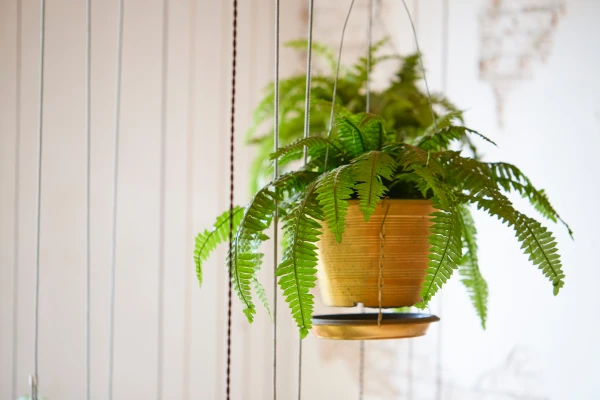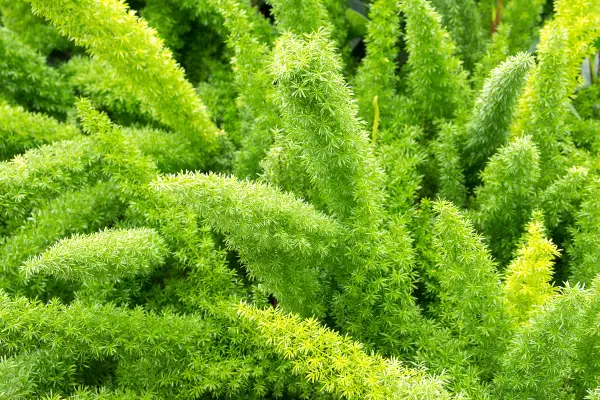Ferns are one of the most common types of houseplants. From adorning your office to livening up the outdoor shed, ferns are beautiful plants and seem to beautify any space! With over 50 types to choose from, these plants are sure to add some drama to a dull setting and will last a while if they’re taken care of properly.
Taking proper care of ferns will make them last for years to come, even decades! Outdoor ferns thrive in partially lit areas, while the ones indoors could use a little sunshine. They’re not very prone to insects or diseases, so you don’t have to worry about malaria or dengue brewing in your backyard. But, as easygoing and adaptable as these plants can be, there’s always a chance things go awry, and this can easily happen with the way you water them. So, how often do you water ferns? Keep reading to find out!

What Are Ferns?
Before we dive into the how-to’s, it’s important to know what ferns are. Well, we know they are popular houseplants and easy to care for. But ferns, in our opinion, get a lot less credit than they’re due.
They’re one of the oldest types of plants on earth, dating back to prehistoric periods. Herbivore dinosaurs such as Triceratops would have munched on ferns. That should be enough for you to decorate your house with ferns; they were dino food!

Another cool thing about ferns is that they grow just about anywhere! Even if you know nothing about ferns, there’s a pretty good chance you, too, can grow them. Ferns love tropical climates and thrive in all types of weather, except in extremely cold regions like Antarctica.
There are over 10,000 living species of ferns on earth today, including 50 or more separate species that are suitable for being houseplants. Ferns usually sprout in May-June, and if taken care of properly, they will last for years or decades.
Indoor Ferns vs. Outdoor Ferns
Take a look at the comparison below to better understand both types of ferns.
- Indoor ferns prefer indirect sunlight, while outdoor ferns flourish in partially lit areas. See also: Growing Tropical Ferns Indoors
- Boston fern, or the bird’s nest fern, is the most popular type of indoor fern plant. While outdoors, you will be better off with an Australian tree fern or the asparagus fern. You can switch the indoors for the outdoors and vice versa, but remember to take proper care according to their natural habitats.
- When it comes to the soil needs of the two categories of ferns, keep in mind that ferns generally require a moist environment. For indoor ferns, wet and well-drained soil does the trick. For outdoors, strong and acidic soil will help your fern thrive, and a thick mulch layer can also achieve the moisture that ferns usually require.
- Watering needs for indoor and outdoor ferns vary drastically, which is expected. Indoor ferns require a light misting every day, while outdoor ferns need a lot more moisture. We’ll take a closer look in a bit.

How Do You Water Ferns? How Often Should You Water Ferns?
Before you start watering your ferns, take into consideration the size, where you’ve planted them, the soil type, and, if possible, the type of fern you have. But the general rules for watering any type of fern are as follows.
- Check the soil for dampness, and this goes for both indoor and outdoor ferns. Unless it’s clay soil, in which case you have to water less often.
- If it’s an indoor fern, take the plant outside, so you don’t make a mess.
- If the top half of the soil is damp in both indoor and outdoor ferns, leave it be. A light mist on the leaves is good enough.
- If the top half is dry and there are visible cracks, sprinkle water until the soil is damp. For outdoor ferns, if they’re planted in a pot, water until the soil seeps it out. But don’t overflow the pot; just make sure the water reaches the roots.
- If the fern is planted in the ground, then water it until the soil is damp, as there’s already a natural source of water present.
- Aim the water at the soil; watering from above is not going to reach the roots.
Now let’s answer the question, “How Often Should You Water Ferns?” The general rule of thumb for determining how often your ferns need watering is to observe the plant. You can get away with watering indoor ferns every other day. With outdoor potted ferns, however, don’t let the plant dry up before you water it; two gallons every week is enough. A week is also enough for garden ferns unless rainfall occurs, and the ground is visibly moistened.

How Can You Tell If Your Ferns Need Watering?
Observe! If your ferns look dry, the leaves are wilted, the soil has cracked, and there’s browning throughout the plant, it’s time to water the fern. A well-watered fern will just look green, lush, and spread out, while a dehydrated fern will look the opposite.
How to Know If You Are Watering Your Ferns Properly?
If you’re doing it frequently and your ferns look healthy and lush, you’re watering correctly. But even if they look good, it’s important to maintain frequency. Sometimes even a dehydrated fern may look good to you, while a hydrated one may look dull.
If you follow the steps mentioned above, you can prolong the life of your ferns indoors and outdoors. Another key rule to keep in mind while watering your ferns, or any plant for that matter, is, underwatering and overwatering.
Underwatering vs. Overwatering
Underwatering is when you don’t water a plant enough, and overwatering is when you’ve watered a plant beyond its required needs. Both can have adverse effects on the plant and can make or break its lifespan. Let’s dive a little deeper into it,
- Underwatering your ferns can lead to wilting, wrinkled leaves, stunted growth, browning, and the overall fragile health of the plant. Cracked soil is also an important signifier of a dehydrated plant.
- While some of the signs are similar even in overwatered plants, such as stunted growth and wilted leaves, an overwatered plant will show yellow leaves, mossy growth at the roots, and grayish fungi all over the plant. Other signs include muddy soil and a stench from it.
- One type of fern, the Boston Fern, is more susceptible to wilting and shriveling than other types. So keep an eye out for these in particular.

Key Takeaways
Discovering the world of fern care may have initially seemed daunting, but you’ll be pleasantly surprised by how effortlessly you can nurture this prehistoric favorite! Taking care of ferns is easier than you might think. Here are some care instructions to keep in mind:
- The frequency of watering depends on soil type, location of the plant, and fern type.
- Frequency is vital! For indoor ferns, a light mist is needed daily or every other day and potted outdoor ferns need two gallons every week.
- Observation is crucial! Before watering or deciding to withhold water, be sure to check the soil and the fern’s appearance to prevent both overwatering and underwatering.
- Opt for watering directly at the soil level instead of from above.
- The temperature of the water should not be too hot or too cold; room temperature water is best for watering ferns.
Fertilizers also play a key role, so make sure you’re using one that doesn’t soak up all the moisture and leave the fern dehydrated.
Recommended Fertilizers for Ferns
FAQs
The best way to plant an indoor fern starts with selecting a suitable pot that has drainage holes to prevent waterlogging. Choose a high-quality, well-draining potting mix that retains moisture without becoming soggy. Gently remove the fern from its nursery pot, being mindful of the delicate roots. Create a hole in the center of the new pot and place the fern inside, ensuring the soil level matches the height of the fern’s root ball. Fill the remaining space with the potting mix, patting it down lightly to secure the plant. After planting, water the fern thoroughly, allowing any excess water to drain away. Place the fern in a location with indirect light and maintain a consistent watering schedule, ensuring the soil stays evenly moist but not overly wet. Regularly mist the fronds to provide the required humidity, and periodically feed the fern with a balanced liquid fertilizer to promote healthy growth. With proper care and attention, your indoor fern will thrive and bring a touch of greenery and freshness to your living space.
Living in a dry region with limited rainfall presents unique challenges for keeping ferns healthy indoors, but there are several strategies to prolong their lifespan and maintain their lush appearance. Firstly, choose a fern species that is more resilient to dry conditions, such as the Boston fern or the bird’s nest fern, as they can better tolerate lower humidity levels. Next, create a humid microenvironment around the fern by placing a shallow tray filled with water and pebbles beneath the pot or using a room humidifier. Regularly misting the fronds with water also helps to boost humidity levels. Ensure the fern receives bright, indirect light, as direct sunlight in a dry environment may lead to wilting. Be attentive to the plant’s water needs, allowing the top inch of the soil to dry out before watering thoroughly, and avoid overwatering, which can lead to root rot. Lastly, periodically inspect the fern for signs of stress or pests, addressing any issues promptly to maintain its vitality. By implementing these strategies, you can create a more suitable indoor environment for your fern to thrive despite the arid conditions outside.
Final Thoughts on How Often do you Water Ferns
Congratulations! You’ve now embarked on a journey into the fascinating world of ferns, uncovering their origins and learning how to nurture your leafy companion on your desk with care. Keep a watchful eye on your green friend and provide it with regular attention.
Perhaps we’ve ignited a spark of interest within you to welcome one of these captivating plants into your life! Not only do ferns bring beauty to your space, but they also contribute to purifying the air and promoting a sense of tranquility, naturally reducing stress and anxiety. Embrace the legend of the fern, an ancient species cherished even by the mighty dinosaurs, and let it grace your surroundings with its timeless charm. Happy planting!

Darrell has a passion for gardening that he inherited from his father. Go here to read more about the influence his father played in his love for gardening. If you want to send Darrell a quick message, then visit his contact page here.

![How to Water Indoor Plants [Plant Care 101]](https://wraxly.com/wp-content/uploads/2021/03/How-to-Water-Indoor-Plants-Plant-Care-101-1200-1024x576.webp)

![Growing Plants from Cuttings [A Simple Guide]](https://wraxly.com/wp-content/uploads/2021/03/Growing-Plants-from-Cuttings-A-Simple-Guide-1200-1024x576.webp)